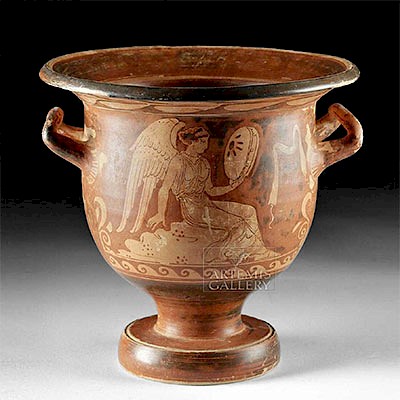Cocle Pottery Spouted Jar in Stingray Form
Lot 211c
About Seller
Artemis Fine Arts
686 S Taylor Ave, Ste 106
Louisville, CO 80027
United States
Selling antiquities, ancient and ethnographic art online since 1993, Artemis Gallery specializes in Classical Antiquities (Egyptian, Greek, Roman, Near Eastern), Asian, Pre-Columbian, African / Tribal / Oceanographic art. Our extensive inventory includes pottery, stone, metal, wood, glass and textil...Read more
Estimate:
$1,500 - $2,000
Absentee vs Live bid
Two ways to bid:
- Leave a max absentee bid and the platform will bid on your behalf up to your maximum bid during the live auction.
- Bid live during the auction and your bids will be submitted real-time to the auctioneer.
Bid Increments
| Price | Bid Increment |
|---|---|
| $0 | $25 |
| $300 | $50 |
| $1,000 | $100 |
| $2,000 | $250 |
| $5,000 | $500 |
| $10,000 | $1,000 |
| $20,000 | $2,500 |
| $50,000 | $5,000 |
| $100,000 | $10,000 |
| $200,000 | $20,000 |
About Auction
By Artemis Fine Arts
Mar 7, 2019
Set Reminder
2019-03-07 10:00:00
2019-03-07 10:00:00
America/New_York
Bidsquare
Bidsquare : VARIETY SALE | Antiquities & Ethnographic Art
https://www.bidsquare.com/auctions/artemis-gallery/variety-sale-antiquities-ethnographic-art-3928
Around the world & back in time - be amazed at the treasures you will find. Antiquities from Egypt, Greece, Italy and the Near East, Asian, Pre-Columbian, African / Tribal / Oceanic, Native American, Spanish Colonial, Russian Icons, Fine Art, much more! Artemis Fine Arts info@artemisgallery.com
Around the world & back in time - be amazed at the treasures you will find. Antiquities from Egypt, Greece, Italy and the Near East, Asian, Pre-Columbian, African / Tribal / Oceanic, Native American, Spanish Colonial, Russian Icons, Fine Art, much more! Artemis Fine Arts info@artemisgallery.com
- Lot Description
Pre-Columbian, Central America, Panama, Gran Cocle culture, ca. 800 to 1000 CE. A polychrome terracotta spouted stingray effigy vessel decorated with red and black pigments upon an orange ground. The stingray presents bulging round eyes, a protruding mouth, pointed fins with concentric circular motifs adorning the fins and curvilinear bands encircling the rim, spout, shoulder and lower body. A fabulous example depicting a highly symbolic animal to the Cocle (see more about its layers of meaning in the extended description below). Size: 5.25" L x 4.125" H (13.3 cm x 10.5 cm)
The stingray is an interesting animal in Cocle lore because of its dualistic and symbolic nature. They are defensive animals who, when provoked, can employ their razor-sharp dorsal spines both as a piercing weapon as well as an applicator of highly-toxic venom to any wounds it inflicts. As professor Jeanette Favrot Peterson explains, "Like shark's teeth, stingray spines were also highly valued as bloodletters, in rituals of self-sacrifice (Benson 1988c). The purpose of offering bloodÂ…was to sustain the cosmos. Thus, the … stingray embodied dual aspects of the underworld, both deadly and indirectly, life-affirming" (Precolumbian Flora and Fauna: Continuity of Plant and Animal Themes in Mesoamerican art. Mingei International Museum, 1990, p. 78).
According to scholar Samuel Kirkland Lothrop, "The Gran Cocle culture is a Pre-Columbian archaeological culture that gets its name from the area from which it was based, the now present-day Cocle province of Panama. The Gran Cocle term applies to a loosely studied group of Native American sub-cultures in this region, identified by their pottery styles. The overall period spans a time from 150 B.C. to the end in the 16th century A.D. upon Spanish contact. The most ancient culture is the La Mula period from 150 B.C. to 300 A.D. The La Mula and later Monagrillo and Tonosa pottery styles are identified by their the use of three paint colors which were black, red and white (or cream). The later Cubitas style saw the emergence of the use of four colors. The styles of Conte, Macaracas and Joaquin added purple to their palette and this hue ranged from grayish tones to red purple. The use of purple disappeared in the subsequent styles of Parita and El Altillo and the paint style reverted back to the use of three colors. Most notable in the artistic renderings are the overt use of geometric designs." (For more information, see Armand Labbe, "Guardians of The Life Stream: Shamans, Art and Power in Prehispanic Central Panama" - Bowers Museum of Cultural Art, University of Washington Press, 1995)
Provenance: ex-private Los Angeles, California, USA collectiona acquired around 1980
All items legal to buy/sell under U.S. Statute covering cultural patrimony Code 2600, CHAPTER 14, and are guaranteed to be as described or your money back.
A Certificate of Authenticity will accompany all winning bids.
We ship worldwide and handle all shipping in-house for your convenience.
#144457Abrasions to peripheries and high-pointed areas with areas of pigment wear as shown. Otherwise very nice.Condition
- Shipping Info
-
All shipping is handled in-house for your convenience. Your invoice from Artemis Gallery will include shipping calculation instructions. If in doubt, please inquire BEFORE bidding for estimated shipping costs for individual items.
-
- Buyer's Premium



 EUR
EUR CAD
CAD AUD
AUD GBP
GBP MXN
MXN HKD
HKD CNY
CNY MYR
MYR SEK
SEK SGD
SGD CHF
CHF THB
THB
















